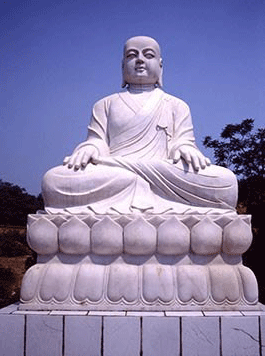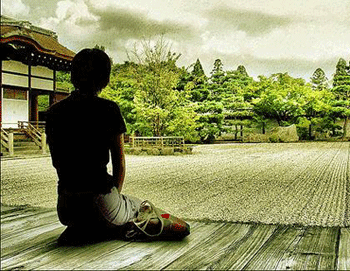“Good health is simply the slowest way a human being can die.” — Unknown
“To talk of Buddhism we must first talk about its origins. I have suggested that the origin of religion was the fear of danger, but this is not true of Buddhism, which arose from the fear of suffering. Please note this distinction. Dealing with the origins of religion we talk about danger, but when dealing with Buddhism we talk about suffering, which has a more specific meaning. The fear of danger has its object in external factors, such as floods, earthquakes, and so on, but suffering includes all the problems experienced in life, including those within the mind.” — Bhikkhu P. A. Payutto
“The Buddhadharma is not far off. It’s as close as your mind. Reality is not somewhere outside. How can you find it, if you turn away from yourself. Whether you’re deluded or awake depends upon you. Make up your mind, and you will be there. Whether you’re in the light or in the dark doesn’t depend on others. Have faith and practice, and you will soon know the truth. If you don’t take the medicine of the Great Physician, when will you see the light of the sun?” — Ming-K’uang – Disciple of the Tientai patriarch Chang-an.
 Twenty-five centuries ago a man awoke to a new reality, he was known as the Buddha. Without the aid of gods or men, he found his way through the tangled web of birth, sickness, old age and death into the everlasting peace of nirvana.
Twenty-five centuries ago a man awoke to a new reality, he was known as the Buddha. Without the aid of gods or men, he found his way through the tangled web of birth, sickness, old age and death into the everlasting peace of nirvana.
Over the years many commentaries have been written to add clarity and understanding to his teachings. Buddhist monks and nuns have taught and still teach his Dharma (Truth). New schools of Buddhism based on culture and meaning arose in every part of the world spreading his message, “Suffering is Optional.”
The Buddha achieved his nirvana at the age of thirty-five. He shared and taught his practice for forty-five years. Buddhist practice is designed to end suffering, transform karma and halt all future rebirths.
Buddhist practice includes both precept practice and meditation practice. The goal of precept practice is the transformation of speech and action. The goal of meditation practice is the transformation of consciousness.
Buddhist practice is also about technique and discipline. Technique, the technical methods and procedures used in Buddhist practice are found in the eight-fold path. The eight-fold path is; right view, right intention, right speech, right action, right livelihood, right effort, right mindfulness and right concentration. Discipline in Buddhism, is the control gained by the practice of training precepts and meditation.
The training precepts are; not to kill, not to take what is not given, not to indulge in sexual misconduct, not to lie and not to consume intoxicants.
Buddhist meditation is composed of both tranquility meditation and insight insight meditation. Meditation allows the cultivator to see clearly, beyond a limited self view and facilitates positive change through heightened awareness.
The practice of the precepts is a key support to the practice of meditation. The training precepts are a necessary and often overlooked component. The goal of nirvana hinges on a combination of precept practice, meditation practice and simplicity (renunciation).
Over time a Buddhist comes to realize he or she has the power to change certain conditions through choice, and accept other conditions through practice. Choice and practice allow the Buddhist to actively participate in his or her own liberation.
Skillful choice is a direct result of Buddhist meditation practice. Meditation adds clarity and understanding to the flux and change of everyday life. What seemed disconnected and arbitrary before, comes together in a web of interconnected cause and consequence.
Karma is the cause, and vipaka (Pali word) is the consequence. Karma can be thought of as the transformation of energy through intention, speech and action. Karma is the principle of conditionality operative on the moral plane.
The potential for suffering is found in every human desire, according to the Buddha. To end our suffering we need to end our desire for existence, for non-existence and for sense pleasure. Nirvana is the end of suffering, because it brings an end to those desires and cravings. It also brings an end to our karma and all future rebirths.
Buddhist cosmology defines rebirth as the transmigration of karma from one life to another. Rebirth is different from reincarnation, as rebirth is not dependent on a soul.
All forms of existence according to the Buddha are ultimately unsatisfactory because of impermanence. The early Buddhists did not believe in the existence of a permanent or fixed reality which could be referred to as God or soul. According to Buddhism what is apparent and verifiable about existence is the continuous change it undergoes.
Early Buddhist teachings proclaim that in this world there is nothing that is fixed or permanent. Every thing is subject to change and modification. “Decay is inherent in all component things,” declared the Buddha, our existence is in a state of flux and continuous becoming. Impermanence and change are the undeniable truths of the human experience.
Rebirth can be viewed as a cause for suffering, sickness, old age and death. When the Buddha entered pari-nirvana – nirvana after death – birth was no longer a condition of his existence. His existence was now established in nirvana, beyond birth and death. Pari-nirvana is the ultimate transformation, beyond space and time. It is existence without birth!
At the age of eighty the Buddha passed and left this advice:
“O bhikshus! Do not grieve! Even if I were to live in the  world for as long as a kalpa (336,000,000 years), our coming together would have to end.
world for as long as a kalpa (336,000,000 years), our coming together would have to end.
You should know that all things in the world are impermanent; coming together inevitably means parting. Do not be troubled, for this is the nature of life. Diligently practicing right effort, you must seek liberation immediately. Within the light of wisdom, destroy the darkness of ignorance. Nothing is secure. Everything in this life is precarious.
Always wholeheartedly seek the way of liberation. All things in the world, whether moving or non-moving, are characterized by disappearance and instability.
Stop now! Do not speak! Time is passing. I am about to cross over. This is my final teaching.”
When the Buddha was young, he learned the science of medicine. He became knowledgeable about the nature and cure of diseases. The Buddha’s realization of the perpetual cycle of rebirth and the stages of aging, illness, and death, enabled him to guide others to live a healthy life.
His pragmatic approach includes the insistence on proper hygiene and medicine, but more to the point, he never resorted to what might be considered “faith healing.” Instead, he offered rational, practical instruction for dealing with both physical injury and mental illness.
Early Buddhism gives us the five Niyamas, or the five aspects of cosmic order. These Niyamas deepen our understanding, and give meaning to why things happen. Niyama is a Pali term for cosmic order. The Niyamas show how certain conditions, laws of nature, work at different levels of cause and effect.
The First Niyama (Utu Niyama) is the law of physical matter. It is the physical, inorganic order of existence. Seasonal changes, earthquakes, floods, gravity and heat are some of the many examples. It roughly embraces the laws of physics and chemistry.
The Second Niyama (Bija Niyama) is the law of living matter, the physical organic order, like cells and genes, whose laws are similar to the science of biology.
The Third Niyama (Kamma Niyama) is Karma. Karma is the activity of transforming energy through intention, speech and action. The result of this energy transformation is only considered wholesome or skillful if less suffering or no suffering is produced. Karma is the cause, and Vipaka is the result. It is the principle of conditionality operative on the moral plane. This sequence of cause and consequence replaces a divine law giver. In Buddhism there is a moral law, but no lawgiver and no one to administer it. This Niyama pertains to the world of ethical responsibility.
The Fourth Niyama (Dhamma Niyama) is the Spiritual or transcendent. This principle of conditionality operates on the spiritual level. The natural phenomenon that occurs with the birth of a Buddha, and the reasons for Buddhist Practice are in this group. This Niyama has to do with the spiritual laws that govern ultimate reality.
The Fifth Niyama (Citta Niyama) is mind. This Niyama implies mental activity such as consciousness, perception, conception, etc. Mental phenomenon arises because of conditions; the mind is not an independent agent. This is like the science of psychology.
The Utu, Bija, Kamma, and Citta Niyamas are types of conditionality in the relative sense, the cause and consequence of everyday life. Dhamma Niyama has to do with the spiritual laws that govern ultimate reality, like emptiness, not-self or our progress through the different stages of the Buddhist path.
These ever changing physical, biological, psychological, ethical and spiritual components give life to our pain and suffering. Our existence and ultimately our death and rebirth, or nirvana depend on a complex combination of aggregates. There is no ‘One Thing’ that determines anything in Buddhism it is always the interconnected and interdependent flux of many things.
The Buddhist approach to health and healing is its emphasis on spiritual practice. Buddhism asserts that spiritual practice makes it possible for an individual not only to see opportunity for practice in the face of adversity, including sickness and injury, but use the opportunity for personal transformation and transcendence.
Buddhist practice allows for a deep awareness of cause and consequence, and insight into the nature of conditioned interdependence. Choice and practice, are the two factors the Buddhist patient has most control over. As a result of precept practice, meditation practice and skillful choice, the Buddhist patient suffers less and has a greater sense of confidence and well-being.
Practice can replace the feelings of being a victim with being a victor. Inspire the patient to view the world as being interconnected and living beings as brothers and sisters, and lastly to turn his or her thoughts towards nirvana and the welfare of all living things.
Buddhism doesn’t tell the patient the meaning of sickness, so much as it tells him what he needs to do. Buddhism is a present moment path of action in life, sickness and death. The Buddhist patient can’t change the past, but he does have some control over the future, if he can act with skill and clarity in the present moment.
There is a story about an Indian king on the battlefield shot through the chest with an arrow. The medic ran to his side, prepared to pull out the arrow. The king said, “No, not yet. I need to know from what caste the archer came, what type of feathers were used, and who made the bow.” The medic said, “If we take the time needed to answer those questions, you will die.”
In Buddhism it’s not about, “Why me?” It’s about, “How can I use this in my practice?”
When medical professionals and Buddhist clergy work together, the Buddhist patient will have a greater sense of acceptance, be encouraged to focus on both mind and body, and in the process transcend pain and suffering.
* A note on Buddhist words. Pali (Language of Early Buddhism) and Sanskrit (Language of India) are often used in the place of English when explaining Buddhism. It can be a bit confusing at first because of there similarity. For instance; Sutra (Sans) Sutta (Pali), Karma (Sans) Kamma (Pali), Dharma (Sans) Dhamma (Pali), Nirvana (Sans) Nibbana (Pali).
(Kusala Bhikshu)




